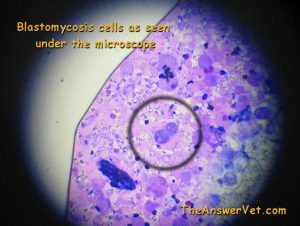
Story at-a-glance
- Histoplasmosis is a potentially very serious fungal infection that has been reported in over half the states in the U.S.; it is most often seen in outdoor dogs and cats, and hunting dogs
- Coccidioidomycosis, often called valley fever, is a potentially deadly infection that occurs in dry, hot climates
- Cryptococcus is caused by a yeast-like fungus found primarily in pigeon feces; infections are most often seen in immunocompromised cats
- Blastomycosis is a common fungal infection that is seen most often in dogs that spend a great deal of time outdoors, and live close to a body of water
- If you live where fungi are prevalent, it’s important to learn what types of organisms your pet might be exposed to, and signs of infection to watch for
By Dr. Karen Shaw Becker
When most people think of fungal infections, they often think of athlete’s feet or candida (yeast). But whatever comes to mind when you think “fungus,” it isn’t pleasant, especially when it’s diagnosed in your pet.
Fungal infections often affect the skin of dogs (and less often, kitties), but they can also occur internally in your pet, spreading through the bloodstream and potentially entering the lungs, which can have severe consequences. Many of these infections are caused by fungi in the environment, and go by impossible-to-pronounce names like histoplasmosis, coccidioidomycosis, cryptococcus and blastomycosis.
Histoplasmosis
In the U.S., histoplasmosis has been reported in 31 states, primarily in the midwest and south, especially along the Mississippi, Missouri and Ohio rivers. Areas with bird and/or bat droppings are also friendly environments for the fungus.
The fungi spores are airborne and can be inhaled by pets, where they engage the immune system, reproduce and then travel throughout the body in the bloodstream. They ultimately wind up in the respiratory tract, gastrointestinal (GI) tract, lymph nodes, bone marrow, lungs, liver and spleen.
Both dogs and cats can acquire histoplasmosis, but the infection is most often seen in outside dogs and cats and particularly hunting dogs. Pets of any age can be affected, but most infections occur in animals under the age of 4.
Symptoms of infection range from none to severe. When they occur, initial symptoms can include loss of appetite and weight loss, diarrhea and bloody or fatty stool, difficulty breathing, coughing, and fever. As the infection progresses, pets can become emaciated, have elevated heart and respiration rates, lameness, and ulcerated sores on the skin or around the eyes.
In addition to the GI and respiratory tracts, histoplasmosis can affect a number of other organ systems including the liver, spleen, lymph nodes, bones and bone marrow, adrenal glands, kidneys, testes, and the mouth, tongue and eyes.
In mild cases of the respiratory form of histoplasmosis, treatment may not be necessary, because your pet’s body may mount an effective immune response and clear the infection on its own. If the infection is severe, hospitalization and aggressive treatment with antifungal medications and supportive therapies may be needed to save your pet’s life.
Your integrative veterinarian will probably suggest adjunctive therapies, like nebulization therapy if the fungus is in the lungs, or ozone therapy if there is a systemic infection. Many animals also benefit from IV vitamin C therapy, which provides tremendous antioxidant and immune system support.
Coccidioidomycosis
Coccidioidomycosis, also known as California fever, desert fever and most commonly, valley fever, is a deadly infection that primarily occurs in dry, hot climates like those found in parts of the western and southwestern U.S., especially Southern California, Arizona, southwest Texas, New Mexico, Nevada and Utah, as well as in Central and South America.
Coccidioidomycosis occurs more often in dogs than cats, but it is not zoonotic, meaning it can’t be passed from animal to human or human to animal. Pets can acquire the infection from inhaling soil contaminated with the fungus. Dogs susceptible to the infection can become ill from as few as 10 fungal spores.
The infection starts in the respiratory tract and then frequently spreads to other body systems. If endospores get into the lymphatic and circulatory systems, they create a systemic infection. Dogs who are outdoors a great deal are at highest risk for valley fever.
Some dogs can develop immunity and never show any symptoms. When symptoms do occur, they include fever, coughing, difficulty breathing, lethargy, lameness, swelling of bones or joints, significant weight loss with muscle wasting, enlarged lymph nodes, skin ulcers and draining sores, inflammation of the cornea or iris of the eye, seizures, and heart failure.
It’s not unusual for valley fever to spread throughout the body, affecting bones and joints, eyes, skin, liver, kidneys, central nervous system, cardiovascular system and reproductive organs (specifically the testes).
Cats usually don’t exhibit the same symptoms as dogs do, and frequently show no symptoms at all until the infection has spread significantly. In cats, the deeper layers of skin tissue are more often affected, so symptoms like masses, abscesses and lesions with draining are more common in kitties.
Treatment of valley fever depends on the extent of the infection and clinical symptoms. If the condition is widespread, traditional treatment involves aggressive antifungal therapy for up to a year. Other drugs, including cough suppressants and steroids, may also be prescribed to treat individual symptoms.
In dogs that aren’t responding well to drug therapy, a drug level measurement test can be performed to determine how well the medication is being absorbed. Integrative veterinarians will often combine traditional antifungal therapy with more natural modalities like cytokine therapy, medicinal mushrooms, IV vitamin C therapy and ozone therapy.
Affected dogs should be fed a high-quality, nutritionally balanced, species-appropriate diet, preferably fresh, to help maintain body weight. Activity should be restricted until symptoms begin to subside. Antibodies should be monitored every three to four months until they return to a normal level.
Unfortunately, valley fever is one of the most dangerous of the fungal diseases, and the prognosis for most dogs is guarded or grave. Sadly, while many dogs improve following a course of antifungal drug therapy, relapse is common.
Cryptococcus
Cryptococcus is a relatively common infection caused by a yeast-like fungus that is widespread in the environment. The condition is much more common in cats than dogs, and is primarily a problem in animals that have weak or compromised immune systems.
A cryptococcal infection is acquired most commonly when a pet inhales the infectious spores in bird droppings, in particular, pigeon droppings. Once your cat inhales the spores, the fungus invades the upper respiratory tract, typically in the nasal passages or the lungs. In immunologically healthy animals, the fungus remains isolated and doesn’t create any problems at all.
But in cats with suppressed immune systems, the disease can take hold and spread to other organs, including the brain, eyes, lungs and the central nervous system. Often, symptoms are systemic and nonspecific, such as diminished appetite, weight loss or lethargy. Other signs to watch for in your pet are sniffling, sneezing, raspy breathing, a runny nose, hard lumpy swellings over the bridge of the nose, skin lesions on the top of the head or swollen lymph nodes.
Eye problems are also very common and can include hemorrhage in the retina, as well as inflammatory conditions of the eye like chorioretinitis and anterior uveitis. If the fungus invades the central nervous system, there can be head tilting, nystagmus (a strange, abnormal back and forth eye movement), the inability to blink due to paralysis of the facial nerves, or loss of coordination, including circling and seizures.
Diagnosis of a cryptococcal infection can be done quickly and easily through examination of either discharge from the kitty’s nose or skin lesions. Once a definitive diagnosis is made, the cat should also receive a complete workup to determine if there’s an underlying disease that has compromised the immune system.
Any underlying conditions must be treated in order to successfully treat the cryptococcal infection. I have only seen the infection in immunocompromised animals, so I encourage you to look for an underlying reason for why your pet acquired the infection.
Blastomycosis
Blastomycosis is a systemic fungal infection caused by an organism that grows in rotting wood and wet soil. Blastomycosis infections are prevalent in locations near water, including the Mississippi, Ohio, Missouri and Tennessee River basins.
The infection is seen most often in large breed male dogs, and especially in hunting dogs, sporting breeds and dogs that spend a lot of time in environments where the fungus exists. Studies indicate most dogs that acquire a blastomycosis infection live within a quarter mile of a body of water.
Symptoms of a blastomycosis infection include loss of appetite, fever, weight loss, depression, inflammation of the iris of the eye and discharge from the eyes as well, coughing, wheezing and pus-filled skin lesions. More serious symptoms can include sudden blindness, lameness, inflammation of the testicles, enlarged lymph nodes and seizures.
Traditional treatment for a blastomycosis infection is long-term oral administration of an antifungal drug. I also recommend a nutraceutical called quantum nucleotide, which helps stimulate an immediate immune system reaction, as well as oil of oregano in capsule form, which is excellent support for a body fighting a fungal infection.
For many dogs, the critical period during treatment is the first 24 to 72 hours, as the antifungal drug begins to kick in and kill off the fungi. Since there are typically a large number of organisms in the lungs, there can be an overwhelming inflammatory response that can result as the fungi die-off. Respiratory distress can be a big problem during the first few days of treatment.
Nontoxic Therapies for Fungal Infections
In addition to conventional therapy for fungal infections, IV vitamin C, hyperbaric oxygen and ozone therapy have all been used to shorten infection time and enhance standard treatment protocols. If your pet has been diagnosed with any of the above fungal infections and is not responding adequately to current treatment protocols, I recommend you seek out these nontoxic, systemic immune-enhancing treatments.
Prevention Is the Best Treatment for Fungal Infections
Since fungal infections in dogs and cats can be life-threatening and often require long-term treatment with powerful, expensive antifungal drugs, obviously, every attempt should be made to avoid exposure in the first place. If you live where fungi are prevalent and/or your pet spends a lot of time roaming outdoors, I recommend you educate yourself on the types of organisms your dog or cat may encounter in your local area, as well as the symptoms of infection.
If you see signs your animal companion may have been exposed to fungi, get him to your veterinarian right away. The earlier a fungal infection is identified and treated, the more likely your pet will make a full recovery.








